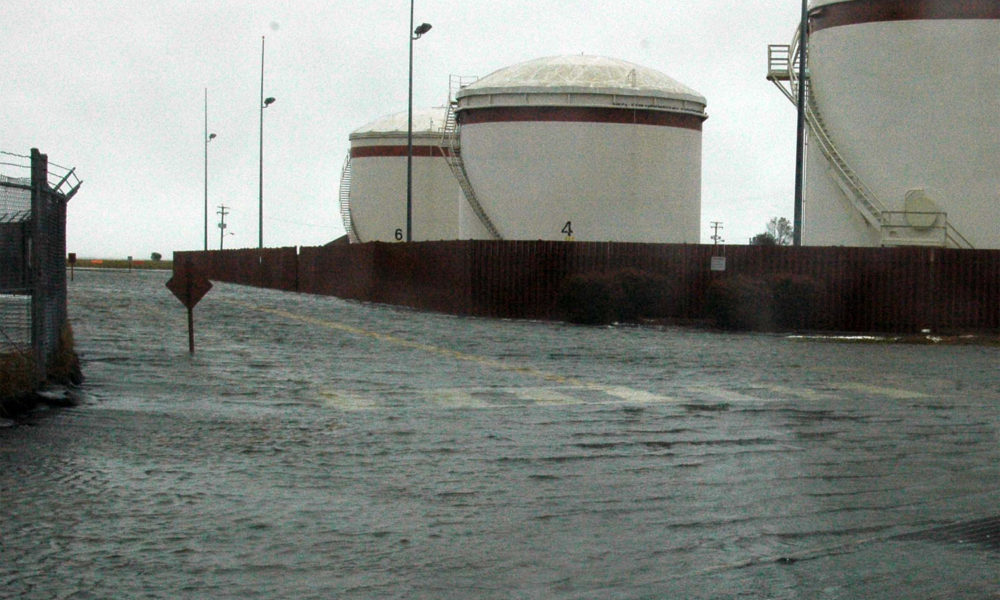Mindy Lubber, the CEO of Ceres, a nonprofit known for galvanizing the investment community around climate change risk, chuckled to remember how puzzled many attendees were at her organization’s first summit on the subject in 2003 at the United Nations.
“We had people from Goldman Sachs, JPMorgan Chase, Bank of America, Morgan Stanley and other executives in the financial sector,” Lubber said over the phone. “They were all wondering why we were inviting them to a climate change summit. They were saying, ‘We thought this was an environmental issue.’”
She said many of them attended in part because massive pension funds such as California’s CalPERS, the nation’s largest public retirement and health benefits system, said it was urgent to do so given that so many of their members were already seeing the effects of climate change. “When the largest fiduciaries and institutional investors began to speak, that helped,” she said.
Still, the United States continued to lag behind Europe in its widespread recognition of the risks climate change poses for property damage from storms and sea level rise, crop losses and, eventually, the stranded assets of fossil fuel facilities as the world shifts to renewable energy. Reinsurance firms like Swiss RE and Munich RE were sounding the alarm two decades ago. J. Eric Smith, then the president of Swiss RE Americas, once told Time magazine, “What keeps us up at night is climate change. We see the long-term effect of climate change on society, and it really frightens us.”
US insurers ignore risks
Many firms in the United States continued to ignore the issue. A joint 2005 report by Swiss RE, the United Nations, and Harvard Medical School’s Center for Health and the Global Environment said, “As of today, fewer than one in a hundred insurance companies, and few of their trade associations and regulators, have adequately analyzed the prospective business implications of climate change, heightening the likelihood of adverse outcomes. This is especially so for US insurers, whose European counterparts have studied the issue for three decades.”
Eventually, a handful of US public officials began to shine a spotlight on the risks. In a 2006 column for the Boston Globe, I interviewed Washington State’s insurance commissioner, Mike Kriedler. He said back then, ‘‘I don’t want to have to get to the point where we have to ask, ‘Do you pump water for vineyards, or run water for turbines, or save it for salmon in the Columbia?’”
Nebraska’s insurance commissioner, Tim Wagner who, along with Kreidler founded a climate change task force for the National Association of Insurance Commissioners (NAIC), talked about unprecedented hailstorms and more droughts.
‘‘I’m a financial guy, not an activist,” said Wagner, who died in 2007. “But we heard about storm models where it would not be unheard of to have a $120 billion storm . . . I don’t know if we’re prepared to be another Netherlands [which has invested heavily in climate mitigation projects]. But it does seem that we are too often in the position of cleaning up after the elephants run by.”
Growing list of climate-related disasters
Intervening years have seen a dramatic increase in the number of severe weather events, from Hurricanes Katrina, Sandy, and Harvey to scorching wildfires in the West and Alaska. This summer is not half over and it will already be remembered for record 100-plus degree heat in Seattle and Portland. But not even these events have inspired a robust national response. At the Ceres 2014 investor summit, Bank of America, Goldman Sachs, Wells Fargo, and Morgan Stanley joined Citi in collectively pledging $180 billion for the financing and investment of renewable energy, energy efficiency, clean transportation, and water and waste projects.
But that was well short of the International Energy’s analysis that $1 trillion per year was needed through 2050 to stem the rapid rise in the Earth’s temperatures. Six years later, a 2020 NAIC report found that only a third of 1,200 insurance companies said they had altered their investment strategy to account for the impact of climate change on their investment portfolios.
Part of the inaction is surely due to the lack of consistent leadership in the White House. We are in a constant state of whiplash, flipping from the climate denial of the George W. Bush administration to the Obama administration’s signing of the Paris climate accords, to the Trump administration’s rollback of Obama’s environmental actions, and now the Biden administration’s attempt to rollback Trump’s rollbacks and accelerate the nation’s drive toward renewable energy such as by jumpstarting the permitting of offshore wind farms.
Biden administration embraces disclosure
In a groundbreaking action, President Biden signed an executive order in May calling upon federal agencies, including the Treasury, to assess and disclose climate-related financial risk across their programs, to seek ways to “improve” those disclosures and to “incorporate climate-related financial risk into regulatory and supervisory practices.”
In an April speech, Biden said the federal government has “a role to play in making sure that material climate risks to financial systems are measured, disclosed, and mitigated. If Wall Street is pumping billions of dollars into business that could be turned upside down when the next storm comes—and we know there will be more storms—Wall Street needs to make clear the risk it’s taking on. Those dollars being invested are often the hard-earned savings of our workers—pensions.”
The European Union is much farther along the path of avoiding these risks. It is not only asking member countries to begin by 2023 to assess how their banking, insurance, and pension systems are helping the EU achieve carbon neutrality by 2050, it announced a new framework this month to increase the flow of private capital into environmentally sustainable investment. Saying “the scale of investment required is well beyond the capacity of the public sector,” the EU estimates it will need an additional infusion of $4 billion during this decade to meet its 2030 emissions reduction targets in the energy sector.
The need to do the same thing in the United States is just as urgent, especially considering that we have 4 percent of Earth’s population but produce 15 percent of global warming emissions. In recent testimony to Congress, my colleague Rachel Cleetus, policy director for climate and energy at the Union of Concerned Scientists, noted that the United States, by its own federal calculations, is hurtling toward a half-trillion dollars’ worth of annual economic losses in a do-nothing scenario on emissions. The biggest losses would come in property, labor, and death from extreme heat.
“Major fossil fuel companies, enabled by investment banks and the lack of a strong federal climate policy framework, continue to double down on fossil fuel investments despite claiming to acknowledge the reality of climate change and touting their commitment to achieving the goals of the Paris climate agreement,” Cleetus said in her written testimony urging Congress to pass a climate-risk disclosure act. “These failures are putting more assets, more investments, more retirement and savings portfolios—and more people—in harm’s way and locking in long-lived high-carbon infrastructure.”
Momentum is building, but so is opposition
People like Lubber are trying to do their part. Building from those early investor summits, Ceres, in concert with other progressive investor groups, this month announced that their list of asset managers committed to coaxing their clients to work toward net zero emissions by 2050 has grown to 128, collectively controlling $43 trillion in assets. That announcement came a month after scores of investors pressed the Securities and Exchange Commission in a letter for strong regulations on climate risk disclosures.
The momentum is building because the evidence is mounting that disclosure is good for business—unless you are a fossil fuel company that refuses to diversify. An analysis published in April in the Harvard Business Review found that the stock market “responds favorably” to climate-change risk disclosures, increasing stock prices by an average of 1.21 percent. “This suggests that investors value higher transparency with respect to climate change risks and that disclosure tends to benefit disclosing companies.” Or, put differently, “investors dislike uncertainty and are willing to pay a premium for less opaque companies,” the authors said.
Despite that analysis, congressional action on climate risk disclosure is being vigorously opposed by a host of fossil-fuel-related industries, represented by the American Petroleum Institute and the US Chamber of Commerce, among others. While claiming that the goals of disclosure are “laudable,” the chamber trotted out the usual rhetoric of “burdensome and impractical mandates” to urge Congress to reject detailed mandatory disclosures in favor of voluntary summary reports.
The rhetoric almost worked; one bill that would mandate that companies disclose “environmental, social and governance metrics” to shareholders passed the House last month by just one vote, 215-214. The measure is supported by the Union of Concerned Scientists and many other groups but its fate in the Senate is uncertain as the Democrats have no votes to spare.
That makes Lubber both sanguine about building momentum for disclosure, particularly in the Biden administration, and sober about the fact that disclosure itself is only a first step.
“We’re still far behind of where we should be,” she said. “Risk disclosure is critical because it is very hard to get to net zero in 2050 if you don’t know where your emissions are. But disclosure itself is just saying “give us the facts.” Disclosure doesn’t automatically mean clean investments. Other countries have put a price on carbon. In the United States, carbon pollution is still free.
“Arm waving about having a goal of net zero by 2050 is no longer enough. We now have to see actual plans and investment actions for 2025, 2030 and 2035. Unless companies gear up now, we can’t get there by 2050.”

